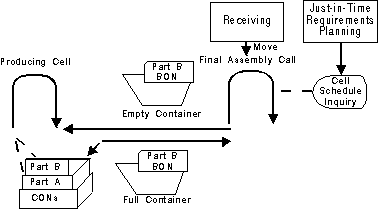Documentation >
MAC-PAC Reference Library >
Manufacturing >
CONBON >
Key Concepts and Procedures >
Dual- and Single-Card CONBON Systems >
Dual-Card CONBON
Dual-Card CONBON
The following example shows a dual-card system in use.
 A Dual-Card System in Use.
A Dual-Card System in Use.
When a container of components is emptied at final assembly (in this case Part B), a material handler or someone from the final assembly cell returns the BON and the empty container to the producing cell. At the producing cell, the material handlers travel to the outbound stores location where full containers, along with their CONs, are located. They exchange the BON for the CON on the full container; place the CON at the back of the dispatch box, which is filled with CONs for other parts; and bring the full container and the BON back to the using cell, which in this case is the final assembly cell. Any number of cells can be connected in this manner.
BONs can also pull material from a stockroom or supplying workcenter. This method can be used to link workcenters that have not been converted to cells.
One-time cards are produced to absorb demand fluctuations that exceed a user-defined percent. These cards, as their name suggests, are used for a short period of time to handle the demand spike and are then discarded, buffering temporary shocks in the system without unnecessarily creating inventory.
Note that the supplying cell only produces more parts when someone from the using cell has signaled it to do so (by detaching the CON from the full container and placing it in the dispatch box). This ensures that only the parts that are needed are produced and that changing priorities are communicated automatically throughout the plant floor. Because the number of cards in the system is proportional to the amount of inventory, CONBON cards can help control inventory levels and expose production process problems. For example, a cell supervisor or team leader may remove a CON or BON from the system, which until now had been running smoothly and without any interruptions in supply to using cells. When the card is removed, a supply interruption occurs. Investigating the problem, the cell team discovers that one of the machines has been incurring excess unplanned downtime. The preventive maintenance procedures are reviewed to stop the problem from occurring again. The added benefit is that now the excess inventory of this part has been reduced by one container quantity.